If you are raising chickens for meat or eggs, you might wonder if it is really worth it. The cost of buying quality, commercial feed from a chain store or feed store is certainly higher than the cost of a few dozen eggs from your grocery store.
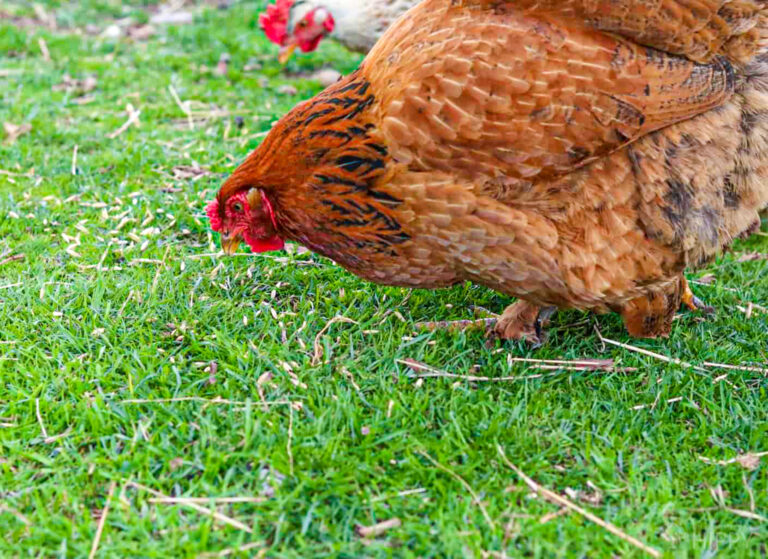
It can be expensive to feed your flock that way, and you may wonder if chickens make a good return on investment when you are trying to feed your family healthy eggs or make money from your chickens. If you’ve been raising chickens for awhile, you know that good quality chicken food simply is not cheap.
There are benefits to using commercial feed. The feed has been scientifically balanced to offer your chickens the right blend of protein, vitamins, minerals, and grains to help them grow and lay eggs.
The feed is consistently formulated, so you will always know what you are getting in your feed. The ingredients are listed right on the bag and it is readily available.
The downside to commercial chicken food is that it is expensive, especially if you are feeding your chickens organic and all natural varieties. The cost of feeding chickens can be discouraging to new chicken raisers.
There are good and healthy alternatives to commercial chicken feed if you are willing to try some other options. In fact, you can raise healthy chickens for little to no money if you are creative with feeding them and don’t mind putting in a little thought and elbow grease.
While it is easy to pick up a bag of commercial feed to give to your chickens, there are much less expensive ways to feed your chickens without going over your budget. Consider these twenty simple ways to feed your chickens for cheap or free.
1. Measure your feed.
Novice chicken owners worry about feeding their chickens enough, so they allow their birds to have free choice layer pellets or scratch grains.
When the bin is empty, they fill it back up. But chickens are pigs! They will gobble down any extra feed you give them, often becoming overweight in the process.
The simple fix to over-feeding your chickens is to measure out your chicken feed each day. The average laying hen will likely consume a quarter pound of quality feed per day, depending on factors such as breed, age, and how frequently the hen lays eggs.
Divide the number of chickens in your flock by four, and that will give you the approximate number of pounds per day to feed your birds.
Bantams will eat considerably less, while very active hens or very large hens will need to eat more. You may have to adjust the feed amount depending on your particular flock, so make sure to ration their feed appropriately.
2. Watch for sales and stock up.
Although commercial feed is expensive, feed stores often have sales and promotions on their chicken feed which make it more affordable. Watch for sales at stores such as Tractor Supply and your local feed stores, especially on the big name brands such as Purina and Dumor.
You may be able to save a dollar per fifty pound bag if you watch for good sales and stock up. Most places will help you load your vehicle if you need it, so be sure you have plenty of room for all that feed.
3. Buy in bulk.
Maybe you don’t have a Tractor Supply near you, but you do have a feed mill, so check to see if you can order in bulk from your local feed mill. You will be able to save money by purchasing a larger quantity of feed with less packaging, as well as saving on gas for all those trips to the feed store.
You will need to store your feed where it is dry and free from rodents so the feed does not mold or become contaminated.
Our local feed store buys bulk bags of pre-formulated feed locally from a feed mill and then passes the savings on to their customers. By buying locally mixed chicken feed from a local feed store, we save three dollars on every fifty pound bag of feed.
4. Buy a quality chicken feeder
You may be tempted to dump all of your chickens’ feed in a big bucket or pan for the sake of feeding your chickens in a hurry. But chickens are sloppy eaters, and will tend to waste their food by spilling it and scratching it out onto the ground, where it gets trampled and dirty.
You can purchase a no-waste chicken feeder from your local feed store or even Amazon.com to keep your chickens from wasting their food. Feeders typically range in cost from $30 to $65 and come in a variety of sizes and types to suit your needs.
You’ll quickly make up for the cost of the feeder with the money you would have spent on the wasted feed. If you have a large flock, you may need several feeders so they can all eat at the same time.
5. Make your own no waste feeder.
If you’re the DIY type, you can make your own DIY no waste chicken feeder. You’ll only need a few tools and a few easy to find parts to compile this low tech feeder. Because chickens naturally scratch at their feed, they tend to spill and waste anything in a bucket or bin.
This no waste feeder works on the principle that chickens can only fit their heads in to get at the food without being able to scratch it out or dump it over.
You will need a large bin or tote with a lid, several PVC elbows large enough to fit a chicken’s head, and something to cut the bin such as an X-Acto knife. Cut a hole on each side of the bin to fit the PVC elbow, several inches up from the bottom.
Put the elbow into the hole, so the chicken can put its head through. You may want to caulk or glue the pipe in place once you are sure that you like the position of the pipes. Fill the bin with the desired amount of food.
The food stays dry and clean and the chickens cannot scratch or dump the feed. This easy and inexpensive project is fun to make and will save your hard-earned cash because it prevents wasted feed.
6. Ferment your feed
Just like making sauerkraut or chow-chow, you can ferment your chickens’ feed to make it stretch farther and add healthy nutrients to their diet. Simply fill a bucket about half full of any good quality chicken feed and then fill your bucket with water, so that it covers the feed by several inches.
Let the feed sit in the water for 3 to 4 days, until it starts to bubble. Stir the feed once a day, making sure the feed is always covered by water so that it does not spoil.
The expanded grains will be more satisfying to your chickens, as well as offer extra nutrition, which leads to healthier hens and healthier eggs. The fermented feed should smell tart or sour, but not rancid or moldy.
7. Feed table scraps.
If you’re eating high quality food, there is no reason your chickens cannot eat it, too. As a mom of six young children, we often have plenty of table scraps left over from my children’s plates.
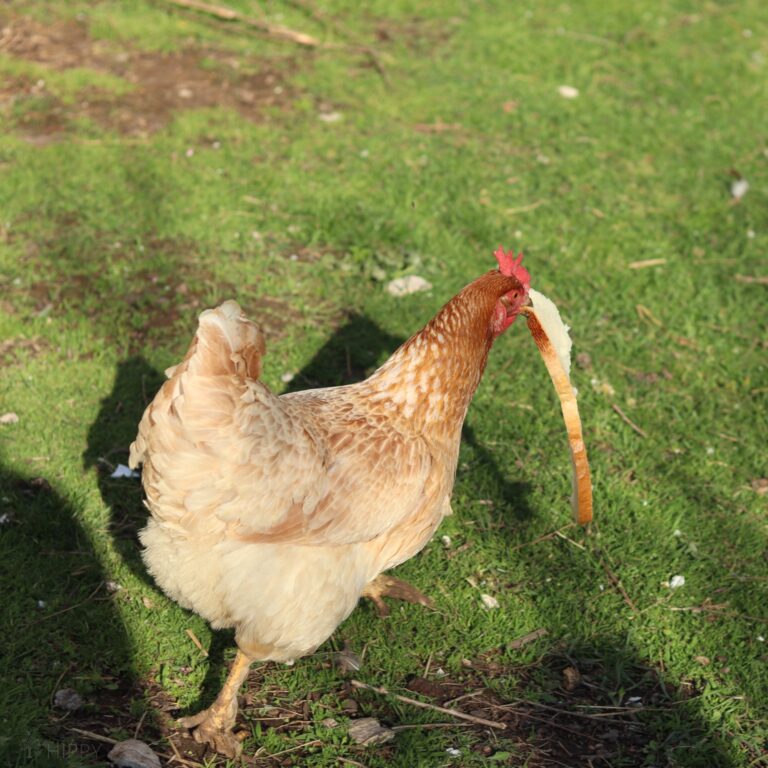
Throughout the day, I scrape all of the leftover sandwich crusts, bits of salad, odd shaped peas, or other leftovers into a container in the fridge. It makes an interesting mash of foods that the chickens love. The next morning, when I feed the chickens, I use the scraps up first and only supplement with commercial feed if I need it.
Whatever we don’t eat, the chickens do! This uses up food that would normally end up in the trash, and satiates your chickens for free. This method saves on the trash bill and on chicken feed costs.
8. Free range your chickens.
There is no question that free range chickens lay some of the tastiest eggs. And the most economical way to save money on chicken feed is to allow your chickens to feed themselves by having free choice of the food that grows naturally in your yard.
The chickens will eat weeds and grass, as well as devour any unwanted pests that cross their paths. Our free range chickens kept the tick epidemic at bay, munched on all kinds of winged creatures and caterpillars, and devoured frogs, toads, snakes, and small rodents.
Not only will this source of protein help your hens stay healthy, it will help keep you and your yard healthy while saving money.
If you are worried about predators attacking your chickens, try free-ranging your chickens in the late afternoon under your watchful eye. You can enjoy their antics while you do yard work, sit in the sun, or any other outdoor activity that you can enjoy nearby.
They will still garner the benefits of free ranging, and so will you, but they won’t be out and about very long before they head back to their coop for bed.
Chickens are great foragers, and will happily scratch and dig their way to their own meal if they have room to roam.
9. Grow a chicken garden.
If free ranging just isn’t an option for you due to local laws or space constraints, you can grow your own chicken garden. Plants such as sunflowers, comfrey, kale, cabbage, and other leafy greens can be grown right in the chicken pen with very little effort.
You may need to cover the seeds with a screen to give them a chance to take root and grow before the chickens have their feast. If you cannot grow a garden in your chicken pen, you might grow vegetables nearby in a garden or container and toss those veggies right to your feathered friends
Or grow veggies around the perimeter of your chicken pen, so they can only eat the leaves and fruit they can reach through your fence. You’ll save on feed while filling them up with vitamins and minerals.
10. Weed ‘em and feed ‘em.
Chickens love weeds! If you have a garden or flower beds, forget burning your weeds or throwing them in the trash can. Instead, toss your weeds like plantain, goosefoot, or comfrey right into your chicken pen. It will keep your chickens full and your garden weed-free.
Please make sure the weeds you feed are free from pesticides or fertilizers. Avoid giving your chickens nightshades, poke weed, azaleas, or other poisonous plants.
11. Sprouts or fodder.
No room for a garden? No problem! Grow sprouts or fodder for your chickens in a small indoor fodder system. It’s as simple as soaking wheat berries, oats, barley, or sunflower seeds overnight and letting them grow for two to six days.
You could purchase prefabricated sprouting trays if you like, or create your own by carefully poking drain holes in the bottom of an old tray or cookie sheet.
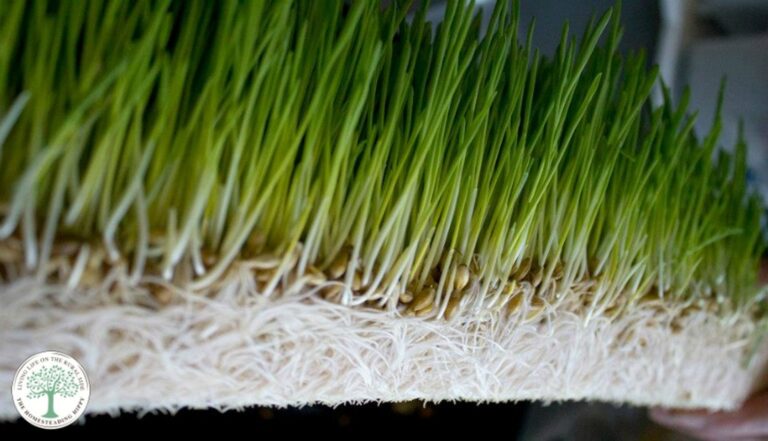
Water and drain your sprouts daily until you feed them to your happy hens. In a pinch, you can even sprout seeds in an old mason jar on your kitchen counter. The sprouts need to be kept above freezing, but won’t need much light to get started.
12. Chickens on compost.
Chickens thrive on compost piles. You can start a compost pile right in the chicken pen if you have enough room. You need one part greens (weeds, leftover veggies, lawn clippings) and two parts browns (dried leaves, straw, paper) layered in your compost pile.
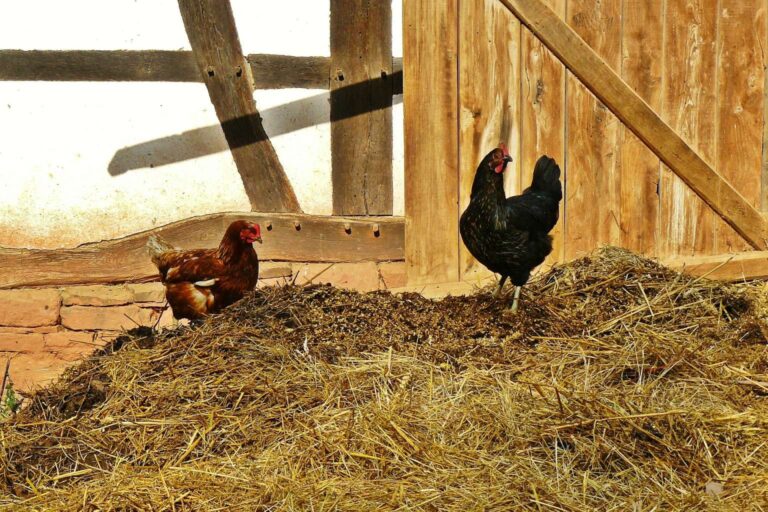
The chickens will keep the compost turned for you while adding their very own fertilizer (chicken poop!), and the compost will feed the chickens with weeds, bits of produce, and the worms and bugs that are attracted to the pile.
You may need to moisten the compost from time to time using water or even rabbit urine to keep the pile heated and active. An active compost pile will give your chickens a warm place to go in the winter time, as well.
13. Give them bugs.
Large garden pests can be a big pain, unless you feed them to your chickens. In the early morning, when you weed or water your garden, you can flick large caterpillars, squash bugs, and beetles off of your precious vegetables and right into a bucket. Take that bucket right to your chickens and watch the free feeding frenzy as they eat up your garden pests.
14. Raise meal worms.
Chickens adore bugs of all kinds, especially meal worms. For a tasty, high protein treat, you can easily and inexpensively raise mealworms in your garage, basement, or closet.
The setup is simple and uses very little space or resources. Find a small plastic bin with a tight fitting lid. Cut a large hole in the top of the bin, and duct tape a piece of screen over the hole to allow air flow into the bin without allowing the bugs to escape.
Fill the bottom of the bin with an inch or two of bran or oatmeal to be used as bedding for the meal worms. Slice a potato in half and set that in the bottom of the bin as well, to be food for the meal worms.
All that is left is to add your meal worms. You will probably want to start with around 400 or more meal worms to keep production at a steady pace. You can pick up live meal worms at a bait shop, pet store, or even order them online. The worms will turn into small beetles which lay eggs, and the eggs will hatch into more worms.
You will probably need to replace your potato once a week as the meal worms eat it or it becomes moldy. As the hatched eggs grow and darken in color, you can feed them to your chickens or sell them off to your chicken-loving friends. Just be sure to leave enough meal worms growing in the bin to keep your meal worm system producing new worms.
15. Send them in the garden.
At the end of the gardening season, you will have bits of rotten tomatoes, left over carrot tops, and other delicious odds and ends of herbs and plants hanging around in your garden, just perfect for chickens.
Open up your fences and let those chickens run right in! They will devour the leftover veggies and herbs, dig up lots of pests, and leave behind great fertilizer for next year’s produce. But only let them in after you are done harvesting, or they’ll eat up all the veggies you were planning on having for dinner, too.
As an added bonus, the chickens will turn the soil of your garden and help prepare it for the next season. Allowing your chickens to free range in your garden at the end of the harvest is a win-win for you and your chickens.
16. Feed them back their eggs.
Did you forget to the collect the eggs for a couple of days? Or were you caught off guard by a sudden cold snap and discovered you had a few frozen eggs? Do you have a lot more eggs than you can use in a reasonable amount of time? Don’t throw them out, feed them back to your chickens.
Scramble the eggs with any leftovers you have in the fridge and hand them over to your chickens for a dish they will love that is full of healthy protein.
17. Feed them egg shells.
If you eat a lot of eggs, you have a lot of extra egg shells. You could throw them in your compost pile in the chicken pen, or you could feed them to your chickens.
Dry out their egg shells and bake them in the oven and then crush them up into small pieces. The extra calcium from their own shells will help them produce eggs with stronger shells and better nutrition for you.
18. Clean out your pantry, fridge, and freezer.
You may be squeamish about expiration dates, but I guarantee, your chickens are not. The next time you clean out your fridge, freezer, and pantry, make a stash of goodies to feed the chickens.
Food that is expired but has not gone bad is perfectly acceptable to feed to your chickens. They’ll also enjoy dried out pizza, stale bread or cereal, or anything else that is no longer delectable but is still technically edible.
Check your freezer for old freezer-burned meat. Just throw it in the crockpot for the day and feed it to your birds later. They will love it and fill up on food that would just go to waste anyway. Be careful to avoid any food that is moldy, rancid, or at risk for botulism.
19. Pumpkins from your local pumpkin patch.
We love our local pumpkin patch. Not just for the entertainment, the tasty fall treats, and the pumpkin picking experience.
But when the season is over, the generous farmers allow us to fill up our van with as many pumpkins as we can carry before they till the rest into the field for next year.
We stash the pumpkins in the garage for several months and the kids have lots of fun smashing a few open every couple of days so the chickens can get to the insides. The chickens devour the seeds, which may help prevent worms and parasites.
20. Look for local leftovers.
Grocery stores buffets, restaurants, and other eateries and even farmer’s markets may be willing to share their leftover produce and buffet items with you to prevent them from going into the landfill.
You will probably have the best results from local mom and pop eateries, especially if you frequent the establishment and get to know the owners.
If you don’t have luck with local businesses, ask your friends to save their household leftovers by throwing them in a bin in their freezer until they are ready for you to pick up their wasted food.
21. Only keep the chickens you need.
If you only need a dozen chickens to supply enough eggs for your family, why are you raising fifteen?
Think carefully about how many chickens you actually need, because those extra birds are probably eating much more food than you might think.
If you are raising chickens for eggs, make sure all of your chickens are good egg producers – don’t waste money raising ornamental breeds like Silkies if you are only raising them for production.
You can also look for chicken breeds that are good natural foragers and are better at finding their own food.
22. Cull unnecessary flock members.
This might be tough for you to envision, but there might come a time when you need to either give away or cull old hens, old roosters, or chickens that are either genetically undesirable or unproductive.
23. Ration
This is a controversial tip, because providing free-choice feed is a great way to improve your birds’ health and also to improve your overall yields. However, it can backfire if your girls are constantly eating and not producing.
Instead of serving food free choice, only give out a half a pound a day per chicken. If egg production drops, you can add slightly more.
24. Open up the compost bin.
Even if you decide not to grow plants specifically for your chickens, you can reduce your feed bill by allowing your chickens to peck and scratch in the compost pile.
Not only will this provide your chickens with access to valuable nutrients and microbes but it will also till up your compost for you!
Feeding chickens does not have to be complicated nor does it have to expensive. Pick one idea that resonates with you to try, and slowly add more until you are feeding your chickens for very little money at all.
You’ll still have healthy eggs and healthy chickens without the entire cost of expensive commercial feeds.
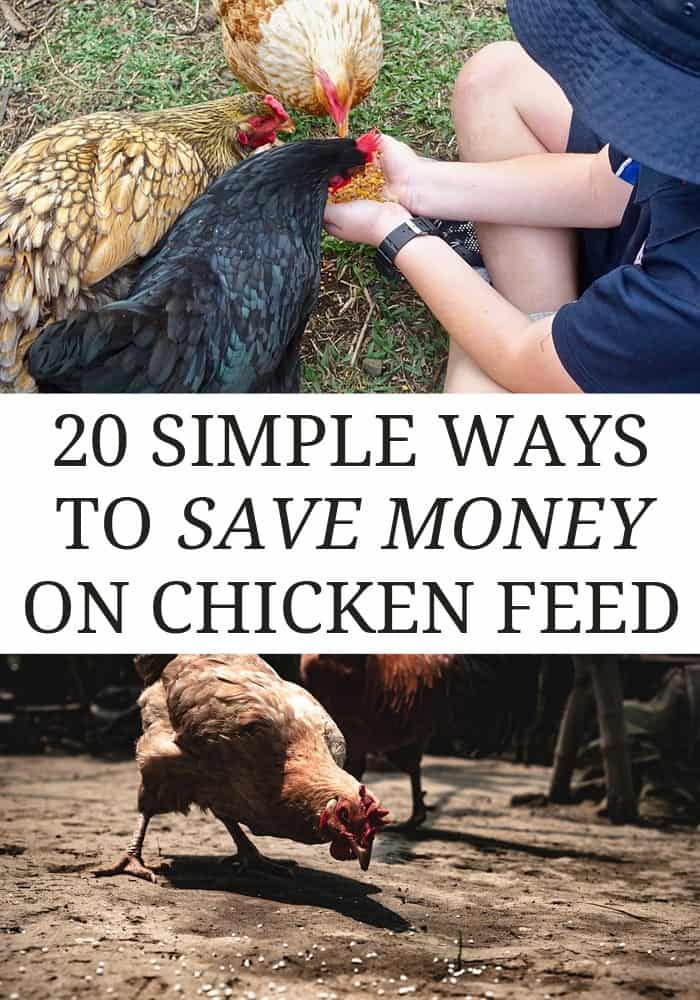

Amanda is a homesteader and a Jesus-loving, mother of 6 toddlers. She’s raising lots of fancy chickens and goats on her small homestead (among other things). Find out more about the team here.

Thank you for this list! I’ve been trying to convince my husband that we need chickens in our large suburban backyard, and this will help so much!
During the summer, I put a light to attract bugs. In the morning… ” Breakfast Bug Buffet. They love it and go straight for it.
I do the same thing, they beline straight over to eat the “goodies”. Mine are in a large covered pen as we has just too many predators here. So every little bit helps.
Great ideas! Thanks for sharing this info! A picture of the homemade feeder would be great!
I’ve found that my chickens will eat most anything. The turkey carcass that you have after thanksgiving can be thrown into the chicken area and they will peck the meat off. Just be aware that these things may also attract unwanted visitors such as racoons, possums, etc., so be careful where you are placing these items.